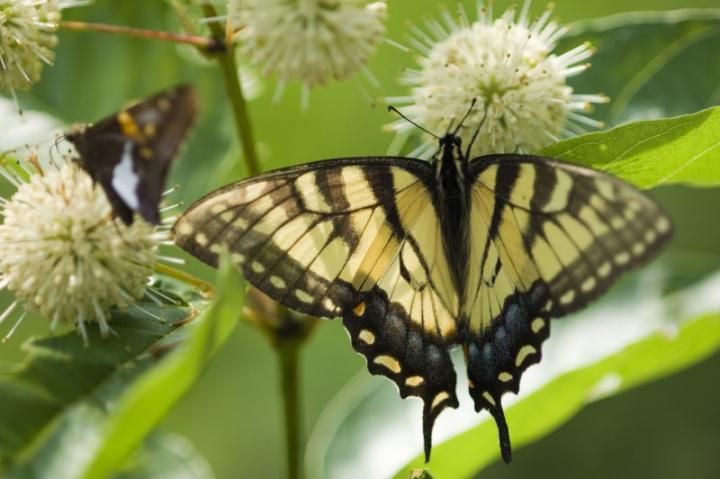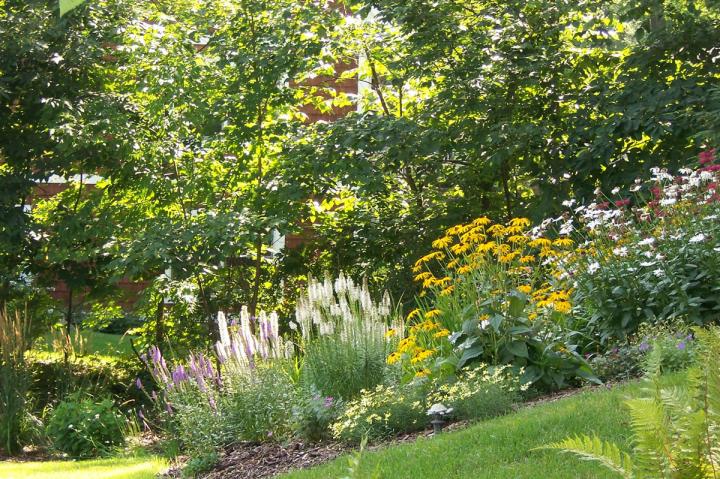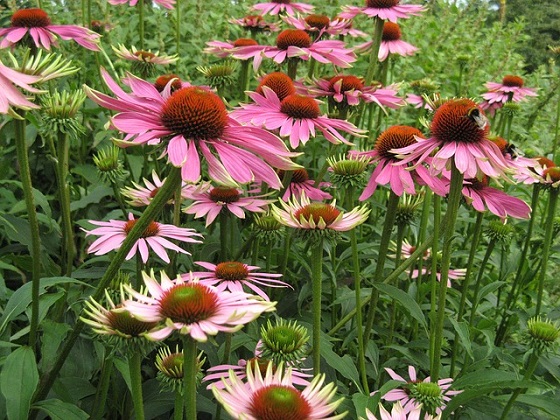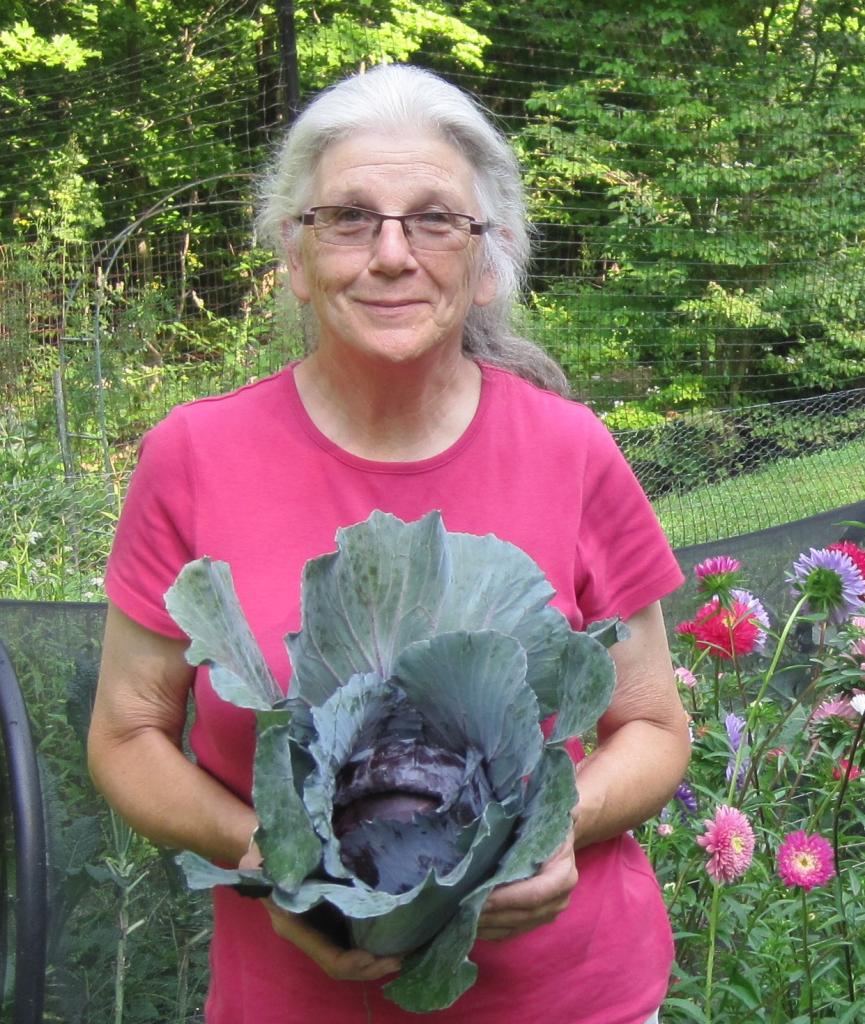Native plants are the best choice for both a low-maintenance and sustainable landscape. Learn more about why native plants are so important for your garden, get a list of common plants that are native to the United States and Canada, and 10 tips on landscaping with native plants.
Benefits of Native Plants to Your Garden
It may seem insignificant, but as gardeners, we can make good choices about our planet and our environment when it comes to our own backyards.
- Large, manicured, weed-free lawns require lots of resources like water, fertilizers, pesticides, herbicides, and gasoline for mowing.
- Many exotic plants also need generous amounts of water, fertilizer, and fungicides to keep them in tip-top shape. Native habitats are often destroyed to make these artificial oases and some of the exotic plants we have introduced have become extremely invasive, choking out native plants and altering ecosystems.
- The loss of even one species has a ripple effect on many interdependent insects, birds, mammals, and plants. Sustainable landscaping works with nature to preserve that delicate balance.
- Native plants are adapted to local growing conditions and don’t require as much pampering as non-natives. Native plants have a much higher rate of survival, since they’re married to the soil and and local climatic conditions—plus, they self-seed!
- Native plants even suppress weeds!
- Native landscaping is safer for you, your family, your neighbors, and your pets, since less chemicals means there’s cleaner runoff and safer water supplies.
- Pollinators need native plants! More pollinators means more flowers and fruits are produced, which is great news for the vegetable garden. Without native plants, we won’t have the bees, butterflies, birds, dragonflies, beneficial bugs, and animal and plant life.

Image: Butterflies on Buttonbush (Cephalanthus occidentalis). Credit: Cornell University.
What Is a Native Plant?
So what makes a plant native? Native Plant Trust defines a native plant as “one that was growing in North America before European settlement.” This includes trees, shrubs, vines, flowering perennials, ferns, and grasses. You probably have a lot of them growing in your yard already.
Once established, native plants are able to withstand the seasonal conditions—such as hot, dry summers and frigid, snowy winters—that they have evolved in. Natives enhance local biodiversity by offering food and habitat for wildlife. Best of all, they give your garden a sense of place. These plants belong in your area and make your landscape a distinctly regional one. When we rely heavily on exotic plants from nationwide chain stores, everyone’s garden starts to look the same!

Lupine
Common Native Plants
Here are examples of native perennials common across the United States and Canada. However, keep in mind that you should aim to plant the particular species native to your area. For example, there are lupine species native to Maine, but there are other lupine species native to California. The Lady Bird Johnson Wildlife Center has the most comprehensive database of native plants that you can search. Local nurseries should be carrying the local species for better survival rate but be sure to ask.
Some of our favorite native flowers include:
- asters
- lupine
- joe pye weed
- columbine
- cardinal flower
- bee balm
.jpg)
The Bee Balm plant is aptly named, attacting native bee and many pollinators!
Native shrubs are also important to your landscape. They provide food and cover for wildlife while offering aesthetic qualities like fragrant flowers, fruit, and colorful fall foliage. Examples of native shrubs include:
- viburnums
- dogwoods
- elderberry
- winterberry
- blueberry
- clethra
- serviceberry
Using a combination of groundcovers, perennials, shrubs, and trees in your landscape mimics natural plant communities, enhancing wildlife habitat. This layered ecosystem can help filter pollutants from the air, provide shade, prevent soil erosion, screen out noise or neighboring eyesores, block winter winds, absorb rainwater and slow runoff.
 Bring natural beauty to your gardens with a native perennial wildflowers. Credit: Prairie Nursery.
Bring natural beauty to your gardens with a native perennial wildflowers. Credit: Prairie Nursery.
Native Plant Landscaping
Landscaping with native plants is sometimes called “naturescaping.” Native doesn’t have to mean wild, though! You can have a garden that is just as refined and glamorous as anyone else’s. Even though it is made up of native plants, the design is up to you.
The secret to success with natives is to pick the right plants to fit your growing conditions; don’t try to remake the conditions to fit the plants. Look around and see what grows wild where you live. These plants will reflect the local growing conditions.

Prairie plants such as liatris and coneflowers (above) are perfect for a hot, dry, sunny location, while tiarella is a fabulous groundcover for a shady spot under tall trees. Blue flag iris doesn’t mind wet feet, while yellow woodland foxglove lights up dry shade.
10 Native Landscaping Tips
As you plan your landscape or garden, follow nature’s lead! See what percentage of your yard you can transform into native planting. Even a small percentage can make a difference! Here are 10 tips to get started:
-
Before you browse plants, look at the hand that nature has dealt you. Let nature hardscape your garden. Are the landforms soft or jagged? Bright or subtle? Is the topography flat or varied? Take notes, then take the hint as you research native plants’ preferences.
-
Work towards removing all invasive shrubs, trees, and plants or they’ll simply take over any area. See more about stopping invasive plants from spreading.
-
Consider how to reduce the size of your lawn, which is a high-maintenance, low-value environment. Try a wider plant border. In the fall, you can smother areas with newspaper and mulch, and then plant natives in the spring. Or, you could try planting “native lawns” with grasses such as Red fescue (Festuca Rubra), Seashore bentgrass (Agrostis pallens), St. Augustine grass (Stenotaphrum secundatum), Buffalograss (Bouteloua dactyloides) and Blue grama (Bouteloua gracilis). It’s important to match your local area and soil. Finally, consider areas that aren’t turf; grow clover instead!
-
Match the soil and the plantings. If your soil is acidic and your chosen plants need alkaline soil, you’re in for a struggle. See our pH preferences chart.
-
Take note of natives that grow in your yard or areas, especially plants that grow in clumps or groups as this will provide an important example of what will succeed and look wonderful. Grow what already grows, or a variant of it. Not sure how to ID the plant? There are many field guides as well as online apps. Google PlantNet, PlantSnap, and iNaturalist.
-
Never remove native plants from the wild; it’s shoplifting. “Ecologically correct” nurseries have spring up in every region of the country. To find native plants that work in your area and native plant nurseries, see Cornell University’s Local Resource Tool. Buy propagated wild plants from a reputable nursery, not a big box store.
-
Look to re-create natural elements on a smaller scale. If you’re considering walls or walkways, use natural stone in natural patterns (unless there is no stone, for then it will look out of place).
-
Blur the garden’s edges. Unlike conventional gardeners, who may end plantings with an edge or a nice, tidy line, consider blurring the edges by gradually reducing the plant’s density toward the perimeter of the garden. Perhaps float a few islands of plants toward or into the wilder landscape, if possible, to lead the eye outward.
-
Don’t fertilize when you plant. Most native communities thrive in areas of low soil fertility. Giving native plants a big meal of nitrogen when you set them out usually is of tremendous benefit to surrounding weeds. Take it slow and easy at first.
-
Weed and mulch frequently, and wait until the plants are established before you decide to give them supplements. Root growth should come first, so don’t be disturbed if plants seem to be making a slow start.
Using native plants is an environmentally-friendly way to make your garden green in more ways than one!
When man demands of nature a change so great and so unnatural, she rebels and refuses to submit.
–The Old Farmer’s Almanac, 1895
See our page on growing wildflowers with a list of widely-adaptable native plants.






.jpg)
 Bring natural beauty to your gardens with a native perennial wildflowers. Credit:
Bring natural beauty to your gardens with a native perennial wildflowers. Credit: 








